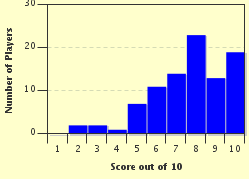Quiz Answer Key and Fun Facts
1. We will start off our quiz in the historical neighbourhood of Charlestown, Massachusetts in the eastern United States. During the American Revolution in 1775, it was the site of the first major battle during the upheaval. One of the famous monuments in this historical location is the Bunker Hill Monument to commemorate where this famous battle took place. What modern day city, also known for an historical "tea party", can we find Bunker Hill?
2. Travelling north and into Canada, we arrive at one of Canada's largest valleys located in the province of Ontario. What valley that also shares the same name as Canada's capital city, might we be visiting?
3. We've booked our flight out of Macdonald-Cartier International Airport and fly out to Heathrow International Airport. Upon our arrival in London, England, our tour guide brings us to a hill that was once famous for executions like those of Simon Sudbury, Thomas Wentworth, and Simon Fraser. What famous London hill is this?
4. Given the chance to visit some of the coolest burial sites in the world, we fly to Luxor International Airport and take a drive to visit a burial site that was designated for Pharaohs and important nobles. One of the more famous tombs is that of Tutankhamen. What famous burial ground would we be at?
5. Heading to the Southern part of the African continent, we visit Signal Hill in the coastal city of Cape Town. Not only is Signal Hill a stunning landmark that was once used for weather communication, but it also shares a name with a National Historic Site in eastern Canada. What Newfoundland capital city also holds an important landmark known as "Signal Hill"?
6. We return to Europe and visit a gorge that became an environmental disaster of sorts during the 1960s and 1970s when two cities, Orsova and Ada Kaleh, were subject to flooding during the building of two hydroelectric dams on the Danube River. What gorge is this that forms a partial boundary between the nations of Romania and Serbia?
7. In the neighbouring country of Bulgaria, we pull into its second-largest city of Plovdiv. It was brought to our attention through the local tourist information centre that Plovdiv is famous for a number of hills that can be found throughout the city. How many hills are scattered in this beautiful city?
8. Heading south to Australia, we travel to the state of South Australia. About sixty kilometers northeast of Adelaide, we come to the Barossa Valley. We head up to Mengler's Hill, a popular tourist lookout spot that over looks the valley. The view from above is astounding as we see what the Barossa Valley has to offer. In fact, we are looking at one of the oldest regions in Australia for what particular industry?
9. A quick trip to New Zealand is sure to be fruitful as we get to visit a volcanic peak in Auckland. Considered to be a Maori memorial place, it is made up of a unique volcanic rock known as scoria. What location with the same name as a 2000s American television sitcom/drama have we encountered?
10. Our final stop on our world tour of hills and valleys is located in California to the east of the Sierra Nevada Mountains. Its traditional Timbisha Native American name translates to "rock paint", while its current English name was derived by prospectors in 1849 during the California Gold Rush due to the hardships associated with this dangerous profession. What world famous valley would this be?
Source: Author
apathy100
This quiz was reviewed by FunTrivia editor
agony before going online.
Any errors found in FunTrivia content are routinely corrected through our feedback system.

